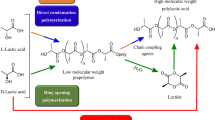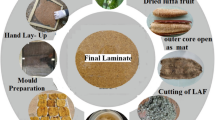Abstract
Water-based spinning dopes composed of enzymatically fibrillated pulp (EFP), poly(vinyl alcohol) and glutaraldehyde crosslinker were successfully spun into monofilaments. Specimens containing EFP concentrations of 50 and 60 wt% were obtained utilising a customised spinning system based on a syringe pump. Monofilaments exhibited high stiffness, good strength and low strain; maximum tensile values were obtained at a cellulose concentration of 60 wt%. Reduced graphene oxide was incorporated into the monofilaments as a lubricant, enhancing elongation while also providing a slight reinforcing effect. Mechanical behaviour was dictated by a synergy of competing interaction-types and mechanisms. Selected monofilaments were coated with cellulose acetate propionate, resulting in enhanced water strength and stability. The stability of the monofilaments was demonstrated in their ability to be tied into a knot, and to be used to prepare two- and three-dimensional structures.






Similar content being viewed by others
References
Åkerholm M (2003) Ultrastructural aspects of pulp fibers as studided by dynamic FT-IR spectroscopy, Ph. D. Royal Institute of Technology, Stockholm, p 71
Alqus R, Eichhorn SJ, Bryce RA (2015) Molecular dynamics of cellulose amphiphilicity at the graphene–water interface. Biomacromolecules 16:1771–1783
Ammar A, Al-Enizi AM, Al-Maadeed MA, Karim A (2016) Influence of graphene oxide on mechanical, morphological, barrier, and electrical properties of polymer membranes. Arab J Chem 9:274–286
Andrade GI, Barbosa-Stancioli E, Mansur AAP, Vasconcelos WL, Mansur HS (2007) Small-angle X-ray scattering and FTIR characterization of nanostructured poly(vinyl alcohol)/silicate hybrids for immunoassay applications. J Mater Sci 43:450–463
Berman D, Erdemir A, Sumant AV (2014) Graphene: a new emerging lubricant. Mater Today 17:31–42
Bjurnstedt A, Lärneklint F (2004) 3D biocomposites for automotive interior parts, M. Sc. Luleå University of Technology, Luleå, p 84
Chang C, Lue A, Zhang L (2008) Effects of crosslinking methods on structure and properties of cellulose/PVA hydrogels. Macromol Chem Phys 209:1266–1273
Colom X, Carrillo F (2002) Crystallinity changes in lyocell and viscose-type fibres by caustic treatment. Eur Polym J 38:2225–2230
Cutter AG (2008) Development and characterization of renewable resource-based structural composite materials, M. Sc. University of California, Oakland, p 256
da Silva Gomes G, de AlmeidaI AT, Kosaka PM, Rogero SO, Cruz AS, Ikeda TI, Petri DFS (2007) Cellulose acetate propionate coated titanium: characterization and biotechnological application. Mater Res 10:469–474
Dantas PA, Botaro VR (2012) Synthesis and characterization of a new cellulose acetate-propionate gel: crosslinking density determination. Open J Polym Chem 2:144–151
Dias CR, Rosa MJ, de Pinho MN (1998) Structure of water in asymmetric cellulose ester membranes—and ATR-FTIR study. J Membr Sci 138:259–267
dos Reis EF, Campos FS, Lage AP, Leite RC, Heneine LG, Vasconcelos WL, LobatoI ZIP, Mansur HS (2006) Synthesis and characterization of poly(vinyl alcohol) hydrogels and hybrids for rMPB70 protein adsorption. Mater Res 9:185–191
Edgar KJ, Buchanan CM, Debenham JS, Rundquist PA, Seiler BD, Shelton MC, Tindall D (2001) Advances in cellulose ester performance and application. Prog Polym Sci 26:1605–1688
Eyholzer C, Bordenau N, Lopez-Suevos F, Rentsch D, Zimmermann T, Oksman K (2010) Preparation and characterization of water-redispersible nanofibrillated cellulose in powder form. Cellulose 17:19–30
Gericke M, Fardim P, Heinze T (2012) Ionic liquids—promising but challenging solvents for homogeneous derivatization of cellulose. Molecules 17:7458–7502
Gilardi G, Abis L, Cass AEG (1995) Carbon-13 CP/MAS solid-state NMR and FT-IR spectroscopy of wood cell wall biodegradation. Enzyme Microbial Technol 17:268–275
Haigler C, Grimson M, Gervais J, Le Moigne N, Höfte H, Monasse B, Navard P (2014) Molecular modeling and imaging of initial stages of cellulose fibril assembly: evidence for a disordered intermediate stage. PLoS ONE 9:1–10
Hämmerle F (2011) The cellulose gap (the future of cellulose fibres). Lenzing Ber 89:12–21
Hikichi K, Yasuda M (1987) Two-dimensional 1H and 13C nuclear magnetic resonance studies of poly(vinyl alcohol). Polym J 19:1003–1012
Isik M, Sardon H, Mecerreyes D (2014) Ionic liquids and cellulose: dissolution, chemical modification and preparation of new cellulosic materials. Int J Mol Sci 15:11922–11940
Jones A, Zeller M, Sharma S (2013) Thermal, mechanical, and moisture absorption properties of egg white protein bioplastics with natural rubber and glycerol. Prog Biomater 2:12
Kabiri R, Namazi H (2014) Nanocrystalline cellulose acetate (NCCA)/graphene oxide (GO) nanocomposites with enhanced mechanical properties and barrier against water vapor. Cellulose 21:3527–3539
Kanis LA, Marques EL, Zepon KM, Pereira JR, Pamato S, de Oliveira MT, Danielski LG, Petronilho FC (2014) Cellulose acetate butyrate/poly(caprolactonetriol) blends: miscibility, mechanical properties, and in vivo inflammatory response. J Biomater Appl 29:654–661
Kono H, Yunoki S, Shikano T, Fujiwara F, Erata T, Takai M (2002) CP/MAS 13C NMR study of cellulose and cellulose derivatives. 1. Complete assignment of the CP/MAS 13C NMR spectrum of the native cellulose. J Am Chem Soc 124:7506–7511
Lai S, Casu M, Saba G, Lai A, Husu I, Masci G, Crescenzi V (2002) Solid-state 13C NMR study of poly(vinyl alcohol) gels. Solid State Nucl Magn Reson 21:187–196
Li Y, Zhu H, Zhu S, Wan J, Liu Z, Vaaland O, Lacey S, Fang Z, Dai H, Li T, Hu L (2015) Hybridizing wood cellulose and graphene oxide toward high-performance fibers. NPG Asia Mater 7:e150
Lim KY, Seong YJ, Kim BC (2003) Reduction of fibrillation of lyocell fiber with cellulose-g-poly(vinyl alcohol) copolymer. Polym J 35:691–696
Liu J, Li Q, Su Y, Yue Q, Gao B, Wang R (2013) Synthesis of wheat straw cellulose-g-poly(potassium acrylate)/PVA semi-IPNs superabsorbent resin. Carbohydr Polym 94:539–546
Luong ND, Pahimanolis N, Hippi U, Korhonen JT, Ruokolainen J, Johansson L, Nam J, Seppala J (2011) Graphene/cellulose nanocomposite paper with high electrical and mechanical performances. J Mater Chem 21:13991–13998
Mandal A, Chakrabarty D (2015) Characterization of nanocellulose reinforced semi-interpenetrating polymer network of poly(vinyl alcohol) and polyacrylamide composite films. Carbohydr Polym 134:240–250
Mansur HS, Sadahira CM, Souza AN, Mansur AAP (2008) FTIR spectroscopy characterization of poly(vinyl alcohol) hydrogel with different hydrolysis degree and chemically crosslinked with glutaraldehyde. Mater Sci Eng C 28:539–548
Masuda K, Kaji H, Horii F (2001) Solid-state 13C NMR and 1H CRAMPS investigations of the hydration process and hydrogen bonding for poly(vinyl alcohol) films. Polym J 33:356–363
Materials Today (December 2013) From cellulose to textile fiber. http://www.materialstoday.com/biomaterials/news/from-cellulose-to-textile-fiber/ Accessed 25 Aug 2016
Pan Y, Peng C, Wang W, Shi K, Liu Z, Ji X (2014) Preparation and absorption behavior to organic pollutants of macroporous hydrophobic polyvinyl alcohol-formaldehyde sponges. RSC Adv 4:35620–35628
Pere JJ, Kemppainen K, Hilyunen J (2015) High consistency fibrillation of pulps with enzymes—benefits and application foresights. 249th American Chemical Society National Meeting and Exposition, 22–26 March, Denver, USA
Poletto M, Ornaghi LH, Zattera JA (2014) Native cellulose: structure, characterization and thermal properties. Materials 7:6105–6119
Qi X, Yao X, Deng S, Zhou T, Fu Q (2014) Water-induced shape memory effect of graphene oxide reinforced polyvinyl alcohol nanocomposites. J Mater Chem A 2:2240–2249
Samyn P (2013) Wetting and hydrophobic modification of cellulose surfaces for paper applications. J Mater Sci 48:6455–6498
Shen L, Patel M (2010) Life cycle assessment of man-made cellulose fibres. Lenzing Ber 88:1–59
Shuai C, Feng P, Gao C, Shuai X, Xiao T, Peng S (2015) Graphene oxide reinforced poly(vinyl alcohol): nanocomposite scaffolds for tissue engineering applications. RSC Adv 5:25416–25423
Singh E, Thomas AV, Mukherjee R, Mi X, Houshmand F, Peles Y, Shi Y, Koratkar N (2013) Graphene drape minimizes the pinning and hysteresis of water drops on nanotextured rough surfaces. ACS Nano 7:3512–3521
Song J, Rojas O (2013) Approaching super-hydrophobicity from cellulosic materials: a review. Nord Pulp Pap Res J 28:216–238
Spoljaric S, Salminen A, Nguyen L, Seppälä J (2013) Crosslinked nanofibrillated cellulose: poly(acrylic acid) nanocomposite films; enhanced mechanical performance in aqueous environments. Cellulose 20:2991–3005
Spoljaric S, Salminen A, Luong ND, Seppälä J (2014) Stable, self-healing hydrogels from nanofibrillated cellulose, poly(vinyl alcohol) and borax via reversible crosslinking. Eur Polym J 56:105–117
Spoljaric S, Salminen A, Luong ND, Seppala J (2015) Elastic, crosslinked poly(acrylic acid) filaments: nanocellulose reinforcement and graphene lubrication. RSC Adv 5:107992–108001
Swerin A, Ödberg L, Lindström T (1990) Deswelling of hardwood kraft pulp fibers by cationic polymers. The effect on wet pressing and sheet properties. Nord Pulp Pap Res J 4:188–196
Wanasekara ND, Michud A, Zhu C, Rahatekar S, Sixta H, Eichhorn SJ (2016) Deformation mechanisms in ionic liquid spun cellulose fibers. Polymer 99:222–230
Wang R, Wang Q, Li L (2003) Evaporation behaviour of water and its plasticizing effect in modified poly(vinyl alcohol) systems. Polym Int 52:1820–1826
Wang M, Olszewska A, Walther A, Malho J, Schacher FH, Ruokolainen J, Ankerfors M, Laine J, Berglund LA, Österberg M, Ikkala O (2011) Colloidal ionic assembly between anionic native cellulose nanofibrils and cationic block copolymer micelles into biomimetic nanocomposites. Biomacromolecules 12:2074–2081
Wang B, Lou W, Wang X, Hao J (2012) Relationship between dispersion state and reinforcement effect of graphene oxide in microcrystalline cellulose-graphene oxide composite films. J Mater Chem 22:12859–12866
Whipple EB, Ruta M (1974) Structure of aqueous glutaraldehyde. J Org Chem 39:1666–1668
Wu N, She X, Yang D, Wu X, Su F, Chen Y (2012) Synthesis of network reduced graphene oxide in polystyrene matrix by a two-step reduction method for superior conductivity of the composite. J Mater Chem 22:17254–17261
Zhu C, Richardson RM, Potter KD, Koutsomitopoulou AF, van Duijneveldt JS, Vincent SR, Wanasekara ND, Eichhorn SJ, Rahatekar SS (2016) High modulus regenerated cellulose fibers spun from a low molecular weight microcrystalline cellulose solution. ACS Sustain Chem Eng 4:4545–4553
Zikeli S (1997) Process of and apparatus for making cellulose products. US Patent 5589125A
Acknowledgments
This work was conducted as part of the Design Driven Value Chains in the World of Cellulose (DWoC) project. The authors wish to thank Tekes (Finnish Funding Agency for Technology and Innovation) for financial support. This work made use of Aalto University Bioeconomy and Aalto University Nanomicroscopy Centre (Aalto-NMC) facilities.
Author information
Authors and Affiliations
Corresponding author
Electronic supplementary material
Below is the link to the electronic supplementary material.
Rights and permissions
About this article
Cite this article
Spoljaric, S., Auvinen, H., Orelma, H. et al. Enzymatically fibrillated cellulose pulp-based monofilaments spun from water; enhancement of mechanical properties and water stability. Cellulose 24, 871–887 (2017). https://doi.org/10.1007/s10570-016-1133-5
Received:
Accepted:
Published:
Issue Date:
DOI: https://doi.org/10.1007/s10570-016-1133-5




